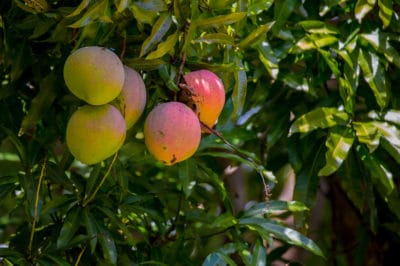Preferred Climate Conditions
Mango (Mangifera indica) trees are well-suited for subtropical and tropical climates where freezing temperatures don’t occur. Gardeners living in USDA zones 9b through 11 can successfully grow one planted in their landscape. However, those living in cooler climates should plant the tree in containers and bring into a protected location when temperatures drop in winter.
Winter temperatures that the tree withstands, damages, or potentially kills mango trees include:
- Mature and healthy mango trees withstand temperatures for several hours as low as 25°F (-3.9°C), suffering some damage to foliage and small branches.
- Young mango trees can be killed when temperatures drop to 29° to 30°F (-1.7° to 1.1°C).
- Immature fruit and flowers can be killed when temperatures drop for several hours to 40°F (4.4°C).
Expert Tip: You can protect trees by watering the root system well the day before cold weather strikes. Shorter mango trees can be covered with a sheet, or have holiday lights strung through them to keep them warm.
Preferred Light & Soil Conditions
For the best production of fruit and flowers, grow the mango tree in a location that gets sun for the vast majority of the day. Planting in a site that is too shady decreases the amount of flowers and thus the amount of fruits. If you are planting in a container, situate it on a sunny porch area.
Mango trees perform well in a vast variety of soils that drain well and though they tolerate occasional flooding, the tree won’t grow well in soils that have a tendency to retain too much water.
If you are worried your selected area to plant the tree is too soggy, plant the mango on a mound that is at least 3 to 4 feet high. This lifts the roots out of the soggy conditions.
For containerized growth, use a potting mix that drains well and doesn’t remain too wet.
Selecting an Area to Plant
When selecting an appropriate site to plant the mango tree, consider that if left unpruned the tree and depending on the cultivar, the tree can grow almost 100 feet tall and 50 feet wide at maturity.
Don’t plant where the tree will interfere with powerlines or a structure and choose a warm location in the landscape. In addition, consider that mango trees can be considered messy, as they drop leaves, flowers and fruits throughout the year.
Expert Tip: Before planting the mango, make sure to clear an area at least 3 feet in diameter of vegetative growth and keep it clean. This reduces the possibility of trunk damage from lawn equipment, and the unwanted growth robs the tree of moisture and nutrients.
Adding a 6-inch layer of mulch helps to retain soil moisture, but be sure to keep it pulled several inches from the mango trunk to reduce the possibility of disease.
Container Selection
If you choose to grow your mango in a container, select one that has bottom drain holes and is large enough so the root system won’t become crowded in a short amount of time. A 5-gallon container is generally large enough for the tree to grow for several years without the need for repotting.
Expert Tips: Whether planting in the landscape on in containers, always plant the mango tree at the same depth it was growing in its nursery container. Planting too deep puts undue stress on the tree. To make it easier to move potted mango trees, consider putting the container on a rolling plant holder.
Water Needs
Immediately after planting, water the mango tree and continue watering every other day for two to three weeks. For the next few months, water the tree several times each week. Thereafter, and for the next three years, water weekly, other than during winter when monthly applications are suffice. Mature and established trees then receive enough water from the environment, unless conditions are extremely hot and dry.
